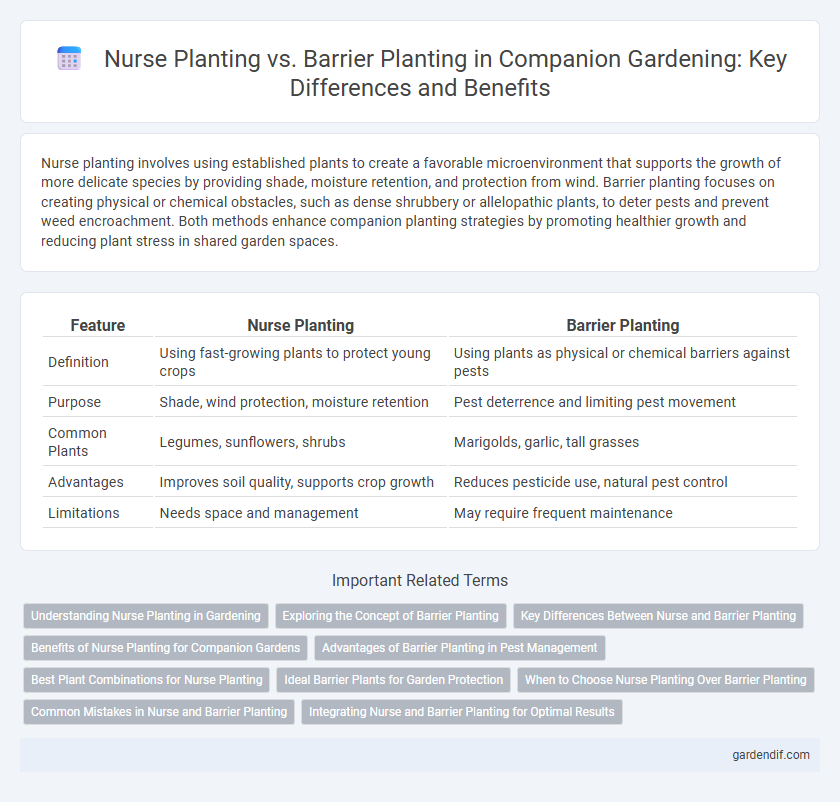
Nurse planting vs barrier planting Illustration
Nurse planting involves using established plants to create a favorable microenvironment that supports the growth of more delicate species by providing shade, moisture retention, and protection from wind. Barrier planting focuses on creating physical or chemical obstacles, such as dense shrubbery or allelopathic plants, to deter pests and prevent weed encroachment. Both methods enhance companion planting strategies by promoting healthier growth and reducing plant stress in shared garden spaces.
Table of Comparison
| Feature | Nurse Planting | Barrier Planting |
|---|---|---|
| Definition | Using fast-growing plants to protect young crops | Using plants as physical or chemical barriers against pests |
| Purpose | Shade, wind protection, moisture retention | Pest deterrence and limiting pest movement |
| Common Plants | Legumes, sunflowers, shrubs | Marigolds, garlic, tall grasses |
| Advantages | Improves soil quality, supports crop growth | Reduces pesticide use, natural pest control |
| Limitations | Needs space and management | May require frequent maintenance |
Understanding Nurse Planting in Gardening
Nurse planting involves using certain plants to create a favorable microenvironment that protects and supports the growth of young or sensitive plants. Unlike barrier planting, which primarily focuses on physical protection or pest deterrence, nurse plants improve soil moisture, provide shade, and enhance nutrient availability, promoting stronger plant development. This technique is vital in gardening for establishing resilient plant communities and improving overall garden health.
Exploring the Concept of Barrier Planting
Barrier planting involves strategically positioning dense or thorny plants to create natural boundaries that protect companion crops from pests and environmental stressors. This method reduces the need for chemical pesticides by physically deterring harmful insects and animals, promoting a healthier garden ecosystem. Selecting species with strong growth habits and resilience enhances the effectiveness of barrier planting in sustainable companion gardening.
Key Differences Between Nurse and Barrier Planting
Nurse planting involves using a fast-growing, often nitrogen-fixing plant to create a beneficial microenvironment that supports the growth of a target plant by providing shade, moisture retention, and soil enrichment. Barrier planting, in contrast, focuses on establishing a physical or chemical barrier with plants that deter pests or weeds, protecting the main crop from harm. The key difference lies in the functional goal: nurse plants enhance growth conditions, while barrier plants serve primarily defensive purposes.
Benefits of Nurse Planting for Companion Gardens
Nurse planting enhances companion gardens by improving soil quality, conserving moisture, and providing natural shade, which fosters the growth of sensitive plants. This method encourages biodiversity, supports beneficial insects, and reduces the need for chemical inputs by creating a balanced microenvironment. Compared to barrier planting, nurse plants actively promote healthier and more resilient plant communities through symbiotic relationships.
Advantages of Barrier Planting in Pest Management
Barrier planting creates a physical and chemical shield that effectively deters pests from reaching vulnerable crops, reducing the reliance on chemical pesticides. This method enhances pest management by limiting pest movement and interrupting their life cycles, leading to lower infestation rates. Integrating native shrubs or aromatic plants as barriers also promotes biodiversity and supports beneficial insects, contributing to a healthier ecosystem.
Best Plant Combinations for Nurse Planting
Nurse planting enhances plant survival by pairing hardy species with more delicate companions that benefit from improved microclimates and soil conditions. Optimal nurse plant combinations include nitrogen-fixing legumes like Acacia with native wildflowers, and fast-growing shrubs such as Ceanothus supporting slower-growing perennials. These pairings promote soil fertility, moisture retention, and protection from wind or sun, improving overall ecosystem resilience and plant establishment success.
Ideal Barrier Plants for Garden Protection
Ideal barrier plants for garden protection include dense hedges like boxwood, privet, and holly, which create effective physical boundaries to deter pests and animals. Nurse planting supports these barriers by providing companion plants that enhance soil health and moisture retention, promoting robust barrier growth. Combining nurse plants such as clover or comfrey with barrier species can improve garden resilience and long-term protection.
When to Choose Nurse Planting Over Barrier Planting
Nurse planting is ideal when establishing young or sensitive plants that require shade, moisture retention, and protection from wind, promoting natural growth and survival rates. Barrier planting is better suited for areas needing physical protection against pests or soil erosion but offers less microclimate benefits. Choose nurse planting in ecosystems aiming for biodiversity enhancement and organic soil improvement through mutual plant support.
Common Mistakes in Nurse and Barrier Planting
Common mistakes in nurse planting include using incompatible species that compete for resources rather than support growth, leading to weakened main plants. In barrier planting, improper spacing and selection of ineffective or invasive species can fail to protect crops from pests or environmental stress. Both approaches require careful planning and species compatibility to maximize benefits and ensure healthy plant development.
Integrating Nurse and Barrier Planting for Optimal Results
Integrating nurse planting and barrier planting techniques creates a synergistic effect that enhances crop resilience and productivity. Nurse plants provide essential shade, nutrients, and habitat for beneficial insects, while barrier plants deter pests and reduce weed competition, together improving soil health and microclimate conditions. This combined approach optimizes resource use and maximizes protection, leading to sustainable and efficient agricultural systems.
Nurse planting vs barrier planting Infographic

 gardendif.com
gardendif.com